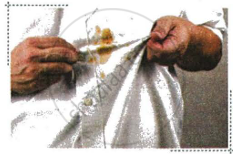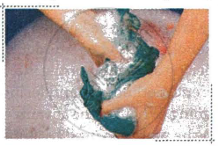Advertisements
Chapters
1: Budgeting and Savings
2: Space Organisation in the Kitchen
3: Home Furnishings
UNIT 2: GROWTH AND DEVELOPMENT DURING MIDDLE CHILDHOOD
4: Milestones of Development
5: Role of Family, Peer Group and School
6: Learning Disabilities in Children
UNIT 3: MEAL PLANNING
7: Balanced Diet
8: Meal Planning for the Family
9: Storage and Preservation of Food
UNIT 4: SELECTION AND CARE OF TEXTILE AND CLOTHING
10: Selection of Fabrics
11: Selection of Readymade Garments
▶ 12: Laundering
13: Laundry Material
UNIT 5: COMMUNICATION AND EXTENSION
14: Social and Economic Issues in India
15: Role of Government Towards A Developed India
16: Communication Aids
![Oswal solutions for Home Science [English] Class 10 ICSE chapter 12 - Laundering Oswal solutions for Home Science [English] Class 10 ICSE chapter 12 - Laundering - Shaalaa.com](/images/home-science-english-class-10-icse_6:c4a0817a5384439cbcd4223e2bb15b2b.jpg)
Advertisements
Solutions for Chapter 12: Laundering
Below listed, you can find solutions for Chapter 12 of CISCE Oswal for Home Science [English] Class 10 ICSE.
Oswal solutions for Home Science [English] Class 10 ICSE 12 Laundering EXERCISES [Pages 165 - 166]
MULTIPLE CHOICE QUESTIONS Choose the correct option
The process of laundering includes these main steps ______.
Storing
Regular washing
Finishing
All of these
The general methods of removing dirt can be done by ______.
Applying friction
Using washing machines
Application of light pressure
All of these
Sorting the clothes for laundering should be according to ______.
Colour of the clothes
Size of the colours
Degree of dirt in the clothes
All of these
Coloured fabrics should be soaked as their colour might bleed.
True
False
Loose dirt is dirt that rests loosely on the surface of the fabric.
True
False
Gum water is used on silk fabric for stiffening.
True
False
Identify the picture
 |
Identify the stain in the picture and select the reagents used to remove it
Glycerine
Methylated spirit
Soap
All of these
Identify the picture
 |
Identify the step of laundering
Boiling
Soaking
Rinsing
Sorting
Identify the picture
 |
Identify the method of removing dirt from the given picture
Application of the principle of suction
Application of friction
Application of light pressure
Washing machine
Fill in the blanks
Colourless fluorescent dyes which turn pale fabrics white making them look brighter are called ______.
Bleach
Blue
Stiffening agents
Optical brighteners
______ method of cleaning uses absorbents and solvents.
Laundry method
Wet method
Dry method
All of these
The ______ method of removing dirt is suitable for all kinds of clothes.
Suction
Steeping
Soaking
Friction
Drip drying can be used for ______ clothes.
Cotton
Silk
Wool
Synthetic
Select the odd one
While washing wool one must remember
It is a weak fabric
Harsh soaps can be used
Gets damaged by heat
Sensitive to acids
Select the odd one
Factor that helps in identifying the stain
Texture of Stain
Smell of Stain
Classification of the stain
Colour of Stain
Select the odd one
The equipment used at home for laundry
Sink
Boiler
Irons
Pipe
SHORT ANSWER TYPE QUESTIONS
Why is the sorting of clothes an important step in the laundering process?
Give two precautions to be followed while drying of woollen garments.
List any two advantages of soaking clothes prior to washing.
What is spot cleaning?
What is the method employed to wash cotton garments?
Name two dry cleaning agents with suitable examples.
What is the method used to wash woollens?
Give one use of talcum powder.
Give one use of petrol.
Give two advantages of starching clothes.
What is the method used to wash woollens?
What is the method used to wash woollens?
What is the method used to wash woollens?
Define dry cleaning.
State two disadvantages of dry cleaning.
Differentiate between wet cleaning and dry cleaning.
Mention any two reasons for boiling clothes during laundry.
Explain the household method of laundering a white cotton shirt.
Write a short note on storage of clothes.
Explain the method of applying friction in the laundering of clothes.
Write a short note on the household method of laundering a silk garment.
What is the method used to wash woollens?
Write a short note on the different methods of laundering clothes.
Mention the principle of dry deaning.
What are the advantages of dry cleaning method over wet cleaning?
What is the difference between the methods used to launder cotton and woollen garments?
Give the list of laundry equipment used at home.
Explain the household method of laundering a white cotton shirt.
Solutions for 12: Laundering
![Oswal solutions for Home Science [English] Class 10 ICSE chapter 12 - Laundering Oswal solutions for Home Science [English] Class 10 ICSE chapter 12 - Laundering - Shaalaa.com](/images/home-science-english-class-10-icse_6:c4a0817a5384439cbcd4223e2bb15b2b.jpg)
Oswal solutions for Home Science [English] Class 10 ICSE chapter 12 - Laundering
Shaalaa.com has the CISCE Mathematics Home Science [English] Class 10 ICSE CISCE solutions in a manner that help students grasp basic concepts better and faster. The detailed, step-by-step solutions will help you understand the concepts better and clarify any confusion. Oswal solutions for Mathematics Home Science [English] Class 10 ICSE CISCE 12 (Laundering) include all questions with answers and detailed explanations. This will clear students' doubts about questions and improve their application skills while preparing for board exams.
Further, we at Shaalaa.com provide such solutions so students can prepare for written exams. Oswal textbook solutions can be a core help for self-study and provide excellent self-help guidance for students.
Concepts covered in Home Science [English] Class 10 ICSE chapter 12 Laundering are Laundering of Clothes, Methods of Cleaning, Laundry at Home, General Methods for Removing Dirt from Fabrics, Common Steps in Laundering at Home (Wet Method), Laundering Specific Fabrics, Laundering of Fabrics Made from Natural Fibres, Laundering of Fabrics Made from Artificial (Or Manmade) Fibres, Difference Between Wet and Dry Methods of Cleaning, Methods of Finishing, Storage of Clothes, Stains and Their Removal, Common Stains and Their Removal.
Using Oswal Home Science [English] Class 10 ICSE solutions Laundering exercise by students is an easy way to prepare for the exams, as they involve solutions arranged chapter-wise and also page-wise. The questions involved in Oswal Solutions are essential questions that can be asked in the final exam. Maximum CISCE Home Science [English] Class 10 ICSE students prefer Oswal Textbook Solutions to score more in exams.
Get the free view of Chapter 12, Laundering Home Science [English] Class 10 ICSE additional questions for Mathematics Home Science [English] Class 10 ICSE CISCE, and you can use Shaalaa.com to keep it handy for your exam preparation.
